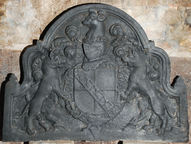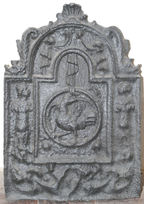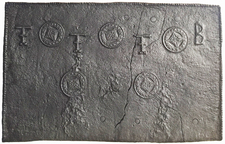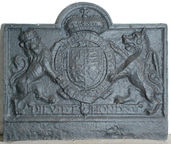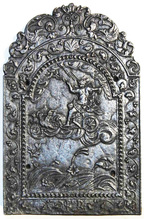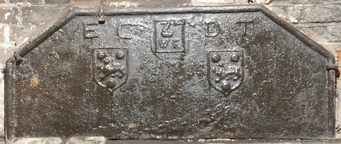-
491
Description: Armorial; one plank line; shield, supporters, helm, crest and garter of the Sackville family: quarterly or and gules, a bend vair.
Notes: The arms of Thomas Sackville (1527-1608), created 1st Baron Buckhurst in 1567 and invested Knight of the Garter in 1589. He was MP for East Grinstead. He was created 1st Earl of Dorset in 1604; the back therefore dates between 1589 and 1604.
Copies of this fireback are known.
Inscription: HONI ... MAL Y PEN ...
Arms: Sackville, Baron Buckhurst
- Decoration tags:
- complex quasi-arched (shape)
- ovolo (edging)
- whole carved pattern
- planklines
- armorial
- text
Manufactured: in the late-16th to early-17th century in the Weald area of England.
Current location: Michelham Priory, Arlington, East Sussex, England.
(part of the Sussex Archaeological Society museum group)
Citation: Butterfield, W. R., 1916, 'Old Wealden Firebacks', The Connoisseur, 46, pp. 197-209.
- Attached to series:
- Ornate border series
- Personal armorial firebacks
- Sackville firebacks
-
492
Description: Arched rectangular central panel; fillet and ovolo edging; a ring suspended with drapery, supporting a bird, its wings displayed and inverted, looking to the right, with a small roundel below it in each corner; arched rectangular border with fillet edging, and symmetrical drapery in the arch; and indistinct figure on each side, and indistinct foliage below; on top, a scllop shell between two descending serpents.
Notes: A bird, usually a parrot, perching on a suspended ring can be seen on other firebacks produced in the Siegerland for the Dutch market in the latter part of the 17th century.
Copies of this fireback are known.
Manufactured: in the late-17th century in the Siegerland area of Germany.
Current location: Michelham Priory, Arlington, East Sussex, England.
(part of the Sussex Archaeological Society museum group)
- Attached to series:
- 'Dutch' Miscellaneous Firebacks
- 'Dutch' Bird on perch firebacks
-
495
Description: Rectangular; twisted rope edging on top and sides; five stamps formed from a circular butter print with a diamond-shaped central element, divided in four, surrounded by a circular border with zig-zag pattern and a raised edge. The letters are interspaced with the top row of three stamps.
Notes: Butter prints were made of wood, and smaller than wafering irons. Formerly part of the J. H. Every collection.
Inscription: T T T B
- Decoration tags:
- rectangular (shape)
- rope (edging)
- simple stamps
- carved stamps
- individual letters
- text
- objects
Manufactured: in the 16th century in the Weald area of England.
Current location: Michelham Priory, Arlington, East Sussex, England.
Museum number: 1944.24.455 (part of the Sussex Archaeological Society museum group)
- Attached to series:
- Food mould stamp firebacks
-
496
Description: Arched rectangular shape; ovolo moulded edging; plain panel at bottom; Tudor royal shield, garter, crown, motto and supporters (crowned lion and dragon), temp. Elizabeth I; the top of the lion's crown and the dragon's ear overlap the edging.
Notes: Another version has a rose and portcullis either side of the crown, and the top of the lion's crown and the dragon's ear do not overlap the edging.
Inscription: [Garter] HONI SOIT QVI MAL E PENSE / [motto] DIEV ET MON DROIT.
Arms: Tudor royal
- Decoration tags:
- rectangular with round arch (shape)
- ovolo (edging)
- whole carved pattern
- planklines
- armorial
- royal
- text
Manufactured: in the mid- to late-16th century in the Weald area of England.
Current location: Michelham Priory, Arlington, East Sussex, England.
Museum number: LH000.999 (part of the Sussex Archaeological Society museum group)
- Attached to series:
- Tudor royal armorial firebacks
- Tudor royal armorial (plain) series
-
498
Description: Arched plate; ovolo moulding edging; shield, supporters, coronet, helm, crest and motto of Viscount Montague; quarterly Browne, Albini, Fitzalan, Fitzalan of Clare, Warren, Maltravers, Nevill, Montagu, Monthermer, Inglethorpe, Burghe, Delapole, Bradeston, Tiptoft, Charleton and Kent (Plantagenet); supporters: two bears collared and chained; the crest: an eagle, the wings elevated and displayed.
Notes: The arms of either the 2nd (Anthony-Maria Browne, succ. 1592-1629) or 3rd viscount (Francis Browne succ. 1629-1682) - the 1st viscount was a Knight of the Garter and no garter is shown; the style of the modelling bears similarities to that on the 1618 series of firebacks and may be the work of the same pattern-maker.
Inscription: 16 / VERITATE DUCE [Be led by Truth]
Arms: Viscount Montague
- Decoration tags:
- rounded arched (shape)
- ovolo (edging)
- whole carved pattern
- armorial
- text
Manufactured: in the late-16th to early-17th century in England.
Current location: Cowdray House ruins, Midhurst, West Sussex, England.
Citation: Dawson, C., 1903, 'Sussex Iron Work and Pottery', Sussex Archaeological Collections, 46, pp. 1-54.
Citation: Gardner, J. S., 1898, 'Iron Casting in the Weald', Archaeologia, 56, 1, pp. 133-164.
- Attached to series:
- Cowdray firebacks
- Personal armorial firebacks
-
499
Description: Arched rectangle; dentil ovolo-moulded edging; shield, supporters, coronet, helm, crest, mantling and motto of Viscount Montague; quarterly Browne, Albini, Fitzalan, Fitzalan of Clare, Warren, Maltravers, Nevill, Montagu, Monthermer, Inglethorpe, Burghe, Delapole, Bradeston, Tiptoft, Charleton and Kent (Plantagenet); supporters: two bears collared and chained; the crest: an eagle, the wings elevated and displayed.
Notes: The arms of either the 2nd (Anthony-Maria Browne, succ. 1592-1629) or 3rd viscount (Francis Browne succ. 1629-1682) - the 1st viscount was a Knight of the Garter and no garter is shown.
Copies of this fireback are known.
Inscription: VERITATE DUCE [Be led by Truth]
Arms: Viscount Montague
- Decoration tags:
- rectangular with round arch (shape)
- dentil ovolo (edging)
- whole carved pattern
- armorial
- text
Manufactured: in the late-16th to early-17th century in England.
Current location: Cowdray House ruins, Midhurst, West Sussex, England.
- Attached to series:
- Cowdray firebacks
- Personal armorial firebacks
-
390
Description: Rectangular; plain plate with shield, supporters, ducal coronet, motto and garter of the Duke of Dorset: Quarterly, Or and gules, a bend vair.
Notes: Almost certainly the arms of Lionel Sackville KG (1688-1765), created first duke of Dorset in 1720. This particular design of fireback has been produced in a variety of sizes depending on the space around the achievement of arms
Copies of this fireback are known.
Inscription: HONI SOIT QUI MAL Y PENSE / AUT NUNQUAM TENTES, AUT PERFICE [Either do not attempt, or complete]
Arms: Lionel Sackville, 1st Duke of Dorset
- Decoration tags:
- rectangular (shape)
- none (edging)
- whole carved pattern
- armorial
- text
Manufactured: in the early-18th century in the Weald area of England.
Current location: in private hands Milford, Surrey, England.
Citation: Lloyd, N., 1925, 'Domestic Ironwork I', Architectural Review, 58, pp. 58-67.
- Attached to series:
- Dorset arms series
- Personal armorial firebacks
- Sackville firebacks
-
1131
Description: Arched rectangular shaped central panel with 'nutshell' edging; pictorial: Mercury in his chariot drawn by two birds (possibly ravens) across the clouds, his caduceus held aloft; above are clouds, below is a landscape with plants; arched rectangular shaped border with fillet edging, a scallop shell top centre with descending symmetrical arrangement of vine and acanthus leaves and tendrils; the monogram, SHR, bottom centre; on top is a symmetrical design of scrolled floral tendrils. One vertical plankline right of centre.
Notes: The design is based on a personification of the planet Mercury in 'Planetarum effectus et eorum in signis zodiaci', by Marten de Vos (1585). Two editions of engravings of de Vos's drawings are known, by Jan Sadeler, dated 1585, and by Gregor Fentzel in about 1650. The holes were for fixing to a grate.
Inscription: SHR
- Decoration tags:
- 'Dutch' (shape)
- fillet (edging)
- whole carved pattern
- planklines
- pictorial
- allegorical
- monogram
- animals
- humans
- plants
Manufactured: in the late-17th to early-18th century in England.
Current location: not known.
- Attached to series:
- SHR series
- British 'Dutch' style firebacks
- De Vos Planets series
-
1203
Description: Arched rectangular central panel with bead on fillet edging; central shield of the Dutch house of Orange impaling English royal Stuart, surmounted by a crown and supported by two putti; above, a maske with two descending grape bunches; below, two more putti seated on scrolls and cornucopiae; a drapery swag and bow in each top corner; arched rectangular border with cavetto-moulded edging and canted top corners; on each side, a Corinthian column and entablature on a pedestal, the columns with floriate decoration; below, a symmetrical swirled design; above the arch, from a scallop shell on each shoulder, two serpents rising towards a third scallop on top.
Notes: The arms are of William IV Prince of Orange (1650-1702) impaling those of his wife, Mary, Queen of Great Britain. Note, these are not the royal arms of William III and Mary II as joint sovereigns, but as Prince and Princess of Orange. William and Mary married in 1677 and Mary died in 1694, so the fireback dates from between 1689, when Mary became Queen, and 1694. A fireback of the same design with the arms of Louis XIV of France is illustrated by Elling and Winkler-Borck, p.213; it has the initials AD in the cartouche above the arch, not visible on this casting.
Arms: William of Orange
Manufactured: in the late-17th century possibly in the Siegerland area of Germany.
Current location: Lassco, Three Pigeons, Milton Common, , Great Milton, Oxfordshire, England.
Citation: Elling, W. & Winkler-Borck, S., 1992, Ofen- und Kaminplatten (Vreden, Hamaland-Museum).
-
1077
Description: Canted rectangle; astragal edging (top and sides); symmetrically arranged, initials separated by overpressed, fillet edged stamp bearing letters WF surmounted by a bent arm holding a battleaxe issuing from a chapeau; beneath are two shields bearing the arms of Fowle.
Notes: The shield and crest stamps relate to William Fowle (1568-1634) and are those used on iron grave slabs in Wadhurst and Frant churches and in Maidstone museum, as well as on other firebacks. The initials have not been identified. Another casting with the same set of initials, but in a slightly different arrangement, has been noted (no. 68), and Christy (1908 p.386) reported on another with slots for two firedogs.
Inscription: EC DT / WF
Arms: William Fowle, of Frant and Wadhurst
- Decoration tags:
- rectangular with canted top corners (shape)
- astragal (edging)
- carved stamps
- individual letters
- heraldic
- armorial
- text
Manufactured: in the early- to mid-17th century probably at Riverhall Furnace, Wadhurst in the Weald area of England.
Current location: in private hands, Minster-on-Sea, Kent, England.
- Attached to series:
- Fowle series
